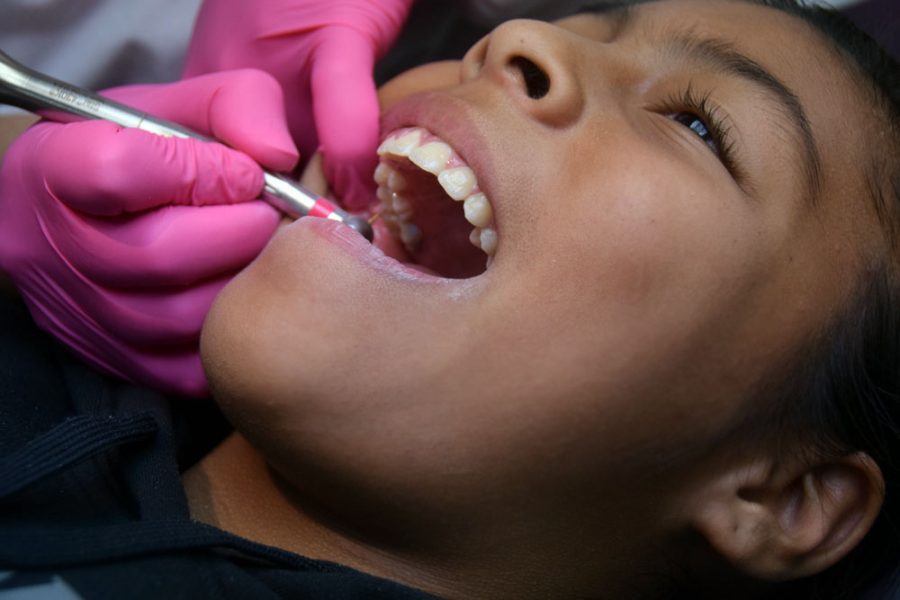Junior Kathleen Twaddle grew up surrounded by braces. Throughout her childhood Twaddle’s father allowed her to roam the family orthodontic practice, exploring the different machines and “assisting” in the appointments. Over the years this proximity to dental healthcare helped Twaddle gain both an in-depth view at all the complexities of braces and firm respect for perfecting smiles.
Then in middle school, Twaddle had her first encounter with actually having braces. Looking back at it now, she describes the brief experience as being largely unnecessary, especially for someone who still had baby teeth. A second round of braces soon followed in seventh grade and, finally, a third in high school. In total, Twaddle has spent roughly five years in braces.
“Every time I got [braces], I wanted them really bad, but then I’d always end up hating them and wanting them off really quick,” Twaddle said. “I always got food stuck in them, and I’d be really self-conscious about it. I’d go to the bathroom every time after I ate to use those little brushes to get rid of any food in my teeth.”
[heading size=”15″ margin=”0″]Challenges[/heading]
For some of the four million in the U.S who have braces, such as junior Amanda Loethen, access to braces isn’t quite as easy. Instead of being easily granted teeth correction, Loethen had to beg for years on end to gradually break down her parents’ resolve.
“I thought that [my teeth] were really gross and that people wouldn’t want to talk to me because the way they looked, because they were so crooked,” Loethen said. “In fact, one of the things I’m most grateful for is braces, because I wanted them for so long.”
Loethen is awaiting the day when she gets her braces off, and she’s not alone. As an orthodontic assistant at Central Missouri Orthodontics, Jessi Botkins often gets to see the moment when, after 18 months to 2 years of gradual improvement, the results are finally revealed. Botkins has noticed a common trend between reactions: patients usually can’t stop smiling and taking selfies. However, for some, the transformative road isn’t as simple as it may seem.
“In general, people don’t realize how much is involved with orthodontics. Once the first few months have gone by and the patient can see how [much] straighter their teeth have already [become,] they are ready for them to come off when, in fact, we still have a lot of work to do,” Botkins said. “Jaw alignment and root placement, among other things, have to be considered when correcting a patient’s mouth.”
The long process of shifting one’s smile isn’t cheap either, as prices range from $3,000 to $7,000 without insurance. Twaddle can empathize with those who can’t afford it, but believes that investing in one’s dental health is something that has a meaningful impact over a lifetime.
[heading size=”15″ margin=”0″]Reflection[/heading]
“Personally I really try to take care of my teeth because I think a good smile is important for first impressions. If a person’s main goal isn’t to have straight, white teeth then I don’t have a problem with it,” Twaddle said. “I think it’s less of a priority to get braces if you don’t have the money, which means you’re at a disadvantage because society does look at smiles as very important to be successful. I think that is unfair.”
Loethen shares Twaddle’s point of view and believes that having crooked teeth isn’t the end of the world, no matter how much self-consciousness it can cause. Although she was embarrassed about her teeth before she got braces, reflecting back on it now she realizes the judgement she felt came more from herself than others.
“When I look at people, I see people’s teeth, but I don’t judge them if their teeth aren’t straight. I don’t think other people really care if your teeth aren’t straight, either,” Loethen said. “It’s not as big of a deal as you feel it is, and you can always fix it when you’re older.”
Furthermore, Loethen hopes that those who have the resources to fix their teeth are truly appreciative, especially since she knows how much of a struggle it can be when it comes to such an important aspect of one’s appearance.
“I think that if your parents made you have braces and you didn’t want them then you should appreciate it because so many people can’t afford them,” Loethen said. “For some people it’s a really big confidence booster, so you should appreciate how your teeth look if they’re straight.”
[note note_color=”#ffffff” radius=”6″]Did you know that the first braces were made by Pierre Fauchard in 1728? Fauchard made his with a flat strip of metal, which was connected to the teeth by pieces of thread.[/note]
Categories:
Braces affect more than one’s smile
January 5, 2017
1
0
More to Discover














































































Alexander Shadwick • Jan 11, 2017 at 9:46 am
I have braces too, but brushing my teeth gets some of the pizza stuff out of my dental system. I use the Christmas tree things, as I never had success flossing with braces; the floss always got stuck in my braces. I also wear rubberbands, which contain latex.